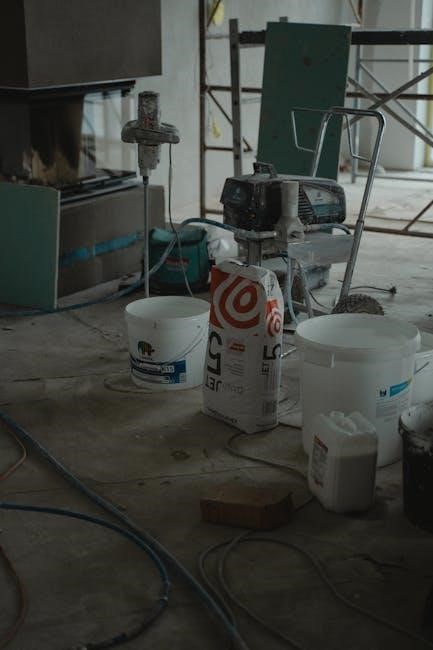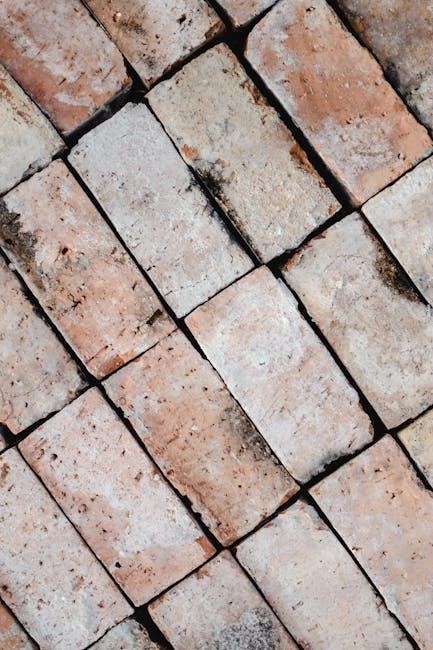Construction materials form the backbone of building projects, ranging from traditional options like cement and wood to modern innovations in sustainable and advanced composites. A well-organized construction materials list in PDF format provides a comprehensive overview, ensuring clarity and efficiency for professionals in tracking quantities, costs, and specifications. This guide offers insights into materials science, classification, and applications, serving as an essential resource for architects, engineers, and contractors. Discover the fundamentals and advancements in construction materials, from natural stone to cutting-edge polymers, all encapsulated in a detailed PDF reference.
Overview of Construction Materials

Construction materials are substances used in building projects, ranging from natural resources like stone and wood to manufactured products such as steel and concrete. These materials are classified into categories based on their properties, uses, and origins. Natural materials, such as sand, gravel, and clay, are often unprocessed and directly sourced from the earth; Manufactured materials, like cement and bricks, undergo processing to enhance their performance. Advanced materials, such as fiber-reinforced polymers and engineered wood, offer improved durability and sustainability. Understanding these materials is crucial for selecting the right options for specific applications, ensuring structural integrity, and meeting project requirements. A comprehensive list of construction materials in PDF format provides a detailed reference for professionals, covering specifications, standards, and applications.
Importance of Construction Materials in Building Projects
Construction materials are vital for ensuring the structural integrity, durability, and safety of buildings. They directly impact the performance, aesthetics, and sustainability of projects. High-quality materials enhance resistance to environmental factors like weather and earthquakes, while substandard materials can lead to structural failures; The choice of materials also influences cost, maintenance, and energy efficiency. Sustainable materials, such as recycled or low-carbon options, reduce environmental impact, aligning with green building standards. A well-organized list of construction materials in PDF format helps professionals make informed decisions, ensuring projects meet specifications and regulations. This guide provides a detailed overview, enabling effective material selection and management for successful building outcomes.
Classification of Construction Materials
Construction materials can be classified into natural and synthetic categories, each with unique properties and applications. Natural materials, such as wood, stone, and clay, are often sustainable and eco-friendly. Synthetic materials, like steel, concrete, and plastics, offer durability and versatility. Additionally, materials are categorized by their structural roles, such as load-bearing elements (e.g., steel, masonry) and finishes (e.g., paints, tiles). Recycled materials, such as reclaimed wood and recycled metals, are increasingly popular for sustainable building practices. A comprehensive list of construction materials in PDF format provides a detailed classification, aiding architects, engineers, and contractors in selecting appropriate materials for specific projects, ensuring functionality, aesthetics, and environmental compliance.

Common Construction Materials
Common construction materials include cement, concrete, steel, wood, bricks, glass, plastics, tiles, aggregates, sand, gravel, and stone. These materials are essential for building projects and can be found in a comprehensive list of construction materials PDF for reference.
Cement and Concrete
Cement and concrete are fundamental construction materials, with cement serving as a binder and concrete as a composite material. Cement is typically made from limestone, clay, and sand, while concrete combines cement, water, and aggregates like gravel or sand. These materials are widely used in foundations, walls, floors, and pavements due to their strength and durability. Portland cement is the most common type, offering versatility for various applications. Concrete can be reinforced with steel for added strength or specialized for specific needs, such as high-strength or decorative finishes. A detailed list of construction materials PDF often includes specifications for cement and concrete, ensuring proper usage and quality standards in building projects.
Steel and Metal Alloys
Steel and metal alloys are indispensable in construction, offering exceptional strength, durability, and versatility. Steel is widely used for structural frameworks, reinforcing concrete, and creating durable buildings. Metal alloys, such as stainless steel and aluminum, provide resistance to corrosion and are ideal for exterior applications. These materials are essential for high-rise buildings, bridges, and industrial structures due to their load-bearing capacity. A comprehensive list of construction materials PDF often includes specifications for steel and alloys, detailing their grades, applications, and mechanical properties. Their adaptability and strength make them cornerstones of modern construction, ensuring safety and longevity in diverse building projects.
Wood and Timber
Wood and timber are natural, versatile construction materials, widely used for structural frameworks, flooring, and decorative elements. Common types include solid timber, engineered wood products, plywood, and lumber. These materials are valued for their strength, durability, and aesthetic appeal. Wood is a renewable resource, making it an eco-friendly choice for sustainable building projects. Modern construction often incorporates treated wood to enhance resistance to moisture and pests. A detailed list of construction materials PDF typically includes specifications for wood and timber, such as grades, dimensions, and applications. Their ability to combine functionality and beauty makes wood and timber essential in both traditional and contemporary architecture.
Bricks and Masonry Materials
Bricks and masonry materials are fundamental components in construction, offering durability and structural integrity. Common types include clay bricks, concrete blocks, and natural stone. These materials are praised for their strength, fire resistance, and aesthetic appeal. A comprehensive list of construction materials PDF often details specifications for bricks and masonry, such as size, weight, and compressive strength. Masonry materials like mortar and aggregates are essential for binding bricks together, ensuring stability. Their versatility allows use in walls, facades, and load-bearing structures. Sustainable options, such as reclaimed bricks, are gaining popularity. Proper selection and application of these materials ensure long-lasting and resilient buildings, making them a cornerstone of construction projects.

Natural Building Materials
Natural building materials, such as stone, clay, sand, gravel, and wood, offer sustainability and aesthetic value. They are widely used in construction for walls, insulation, and decorative finishes, providing durability and a low environmental impact. A detailed list of construction materials PDF often includes these natural options, emphasizing their versatility and eco-friendly benefits, making them a popular choice for environmentally conscious projects and traditional building techniques.
Stone and Rock Materials
Stone and rock materials are integral to construction, offering durability and aesthetic appeal. Common types include granite, limestone, marble, sandstone, and slate, each with unique properties. These materials are widely used for structural elements like walls, floors, and facades, as well as decorative features. Their natural beauty and strength make them popular for both interior and exterior applications. A comprehensive list of construction materials PDF often highlights stone and rock, detailing their specifications, uses, and benefits. This guide helps architects and contractors select the right materials for projects, ensuring quality and longevity. Stone and rock remain timeless choices in modern and traditional building practices.
Clay and Earth-Based Materials

Clay and earth-based materials have been used in construction for centuries, offering sustainable and versatile options. Common materials include clay bricks, adobe, and rammed earth, each providing unique benefits. These materials are eco-friendly, as they often require low energy for production and are locally sourced. A list of construction materials PDF typically includes clay-based products, detailing their applications in structural frameworks and decorative elements. Their natural thermal mass makes them ideal for energy-efficient buildings. While durability in harsh weather conditions can be a challenge, advancements in techniques and additives have enhanced their performance. Clay and earth-based materials remain a popular choice for sustainable and traditional construction projects worldwide.
Sand and Gravel
Sand and gravel are essential construction materials, widely used in concrete, foundations, and drainage systems. Their natural properties, such as high compressive strength and permeability, make them ideal for various applications. A list of construction materials PDF often highlights sand and gravel as primary aggregates, detailing their grades and uses. Sand is finer, while gravel is coarser, making them suitable for different projects. Both materials are abundantly available and cost-effective, contributing to their popularity in building projects. Their quality is critical, with factors like particle size and moisture content affecting performance. Proper testing ensures they meet specifications for strength and durability in construction.
Mud and Thatch
Mud and thatch are traditional construction materials, often used in sustainable and eco-friendly building practices. Mud, a mixture of soil and water, is used for walls and structures, while thatch, made from dried plant material, serves as roofing. These materials are biodegradable, renewable, and locally sourced, making them cost-effective and environmentally friendly. A list of construction materials PDF may include mud and thatch as part of natural and low-carbon building solutions. However, their use is limited by durability concerns and structural weaknesses. Despite this, they remain popular in niche applications, offering unique aesthetic and environmental benefits for certain projects. Their simplicity aligns with ancient construction techniques, promoting sustainability in modern contexts.

Advanced and Modern Construction Materials
Modern construction materials include engineered wood, fiber-reinforced polymers, and smart materials. These innovations enhance durability, sustainability, and efficiency in building projects, as detailed in a construction materials PDF.
Engineered Wood Products
Engineered wood products are a cornerstone of modern construction, offering enhanced strength, durability, and sustainability. These materials, such as glued-laminated timber (Glulam) and laminated veneer lumber (LVL), are designed to minimize warping and shrinking. Unlike traditional wood, they are manufactured to precise specifications, ensuring consistency and reliability. Engineered wood is widely used in structural applications, including beams, joists, and panels, due to its superior load-bearing capacity. Additionally, it contributes to sustainable building practices by reducing waste and preserving natural resources. A detailed construction materials PDF provides an in-depth look at these innovative products, highlighting their benefits and applications in contemporary building projects. Their versatility and environmental advantages make them a preferred choice for architects and engineers.
Fiber-Reinforced Polymers (FRP)
Fiber-Reinforced Polymers (FRP) are advanced composite materials combining a polymer matrix with reinforcing fibers, such as carbon, glass, or aramid. Known for their high strength-to-weight ratio, corrosion resistance, and durability, FRP materials are widely used in structural applications, including beams, panels, and rebar. They are particularly effective in rehabilitation and retrofitting projects, extending the lifespan of existing structures. FRP is lightweight, easy to install, and requires minimal maintenance, making it a cost-effective solution for modern construction. A detailed construction materials PDF highlights FRP’s versatility, environmental benefits, and growing adoption in sustainable building practices. This innovative material is reshaping the industry by offering superior performance and longevity compared to traditional alternatives.
Insulation Materials
Insulation materials are essential for reducing heat transfer, improving energy efficiency, and maintaining comfortable indoor conditions. Common types include fiberglass, cellulose, foam board, and reflective insulation. These materials are widely used in walls, roofs, and floors to minimize thermal conductivity and prevent energy loss. Modern insulation options also offer fire resistance, soundproofing, and moisture control, enhancing overall building performance. A detailed construction materials PDF provides specifications and applications for various insulation products, aiding architects and builders in selecting the most suitable solutions. Proper insulation not only lowers energy costs but also contributes to sustainability and environmental protection by reducing greenhouse gas emissions. This makes insulation a critical component in both residential and commercial projects.
Smart and Self-Healing Materials
Smart and self-healing materials represent cutting-edge innovations in construction, offering adaptive properties and the ability to repair damages autonomously. Self-healing concrete, for instance, uses bacteria or chemical agents to seal cracks, extending the material’s lifespan. These materials are designed to respond to environmental changes, such as temperature or stress, improving structural integrity and durability. Fibers like shape-memory alloys and polymers can revert to their original shape after deformation, enhancing resilience. A detailed construction materials PDF highlights their applications, from infrastructure to high-tech buildings, showcasing their potential to revolutionize the industry by reducing maintenance and increasing sustainability. These advanced materials are paving the way for smarter, longer-lasting structures.

Construction Materials Specifications and Standards
Construction materials must adhere to strict standards like ASTM and ISO to ensure safety, durability, and quality. These specifications outline testing methods, such as hardness and strength, and provide guidelines for material selection and application, ensuring compliance with industry benchmarks and environmental regulations. A comprehensive construction materials PDF details these standards, offering a reference for engineers and contractors to maintain high-quality construction practices. Proper adherence ensures structural integrity and longevity in building projects, making standards indispensable in the industry. This ensures all materials meet required performance criteria, guaranteeing reliability and safety in every project phase. Standards are continuously updated to reflect advancements in material science and technology.
ASTM Standards for Construction Materials
ASTM (American Society for Testing and Materials) standards play a crucial role in ensuring the quality and performance of construction materials. These standards provide detailed specifications for materials like concrete, steel, aggregates, and plastics, outlining testing methods such as compressive strength and hardness. For instance, ASTM C150 covers Portland cement, while ASTM A36 focuses on steel structural requirements. A comprehensive construction materials PDF often includes these standards, offering a centralized reference for engineers and contractors. Adherence to ASTM guidelines ensures materials meet safety, durability, and environmental requirements, making them indispensable for modern construction projects. These standards are regularly updated to reflect advancements in material science and industry needs, ensuring reliability and consistency across all applications.
ISO Standards for Building Materials
ISO (International Organization for Standardization) standards provide global guidelines for building materials, ensuring quality, safety, and environmental sustainability. These standards cover materials like concrete, steel, wood, and plastics, offering detailed specifications and testing methods. For example, ISO 9001 focuses on quality management, while ISO 14001 addresses environmental management. A construction materials PDF often includes these standards, helping architects and contractors adhere to international norms. ISO standards ensure materials meet rigorous criteria, fostering trust and consistency across global markets. By following these guidelines, professionals can select high-performance materials that comply with international building codes, enhancing project durability and safety. These standards are regularly updated to reflect technological advancements and industry needs.
Testing Methods for Material Quality
Testing methods for material quality are essential to ensure construction materials meet required standards. Common tests include compressive strength for concrete, tensile strength for steel, and moisture content for wood. These tests verify durability, safety, and performance. For example, slump tests assess concrete workability, while hardness tests like the Mohs scale evaluate material resistance. Laboratories use advanced techniques like ultrasonic testing for defects and thermal analysis for insulation materials. A construction materials PDF often outlines these testing protocols, providing a reference for quality control. Regular testing ensures materials are reliable, reducing the risk of structural failures. Adhering to standardized testing methods promotes consistency and trust in the construction industry.

Sustainable and Eco-Friendly Construction Materials
Sustainable materials like recycled products and low-carbon concrete reduce environmental impact. A construction materials PDF outlines these eco-friendly choices for greener, efficient, and innovative projects.
Recycled Materials in Construction
Recycled materials, such as reclaimed concrete, steel, and plastics, are increasingly used in construction to minimize waste and reduce environmental impact. These materials, often processed from demolition debris, offer cost-effective solutions while maintaining durability. Recycled concrete aggregates, for instance, are ideal for road bases and non-structural applications. Steel, being 100% recyclable, is another key material, reducing the need for virgin resources. Plastics and glass are also repurposed into insulation and composite materials. A construction materials PDF provides a detailed list of such sustainable options, aiding architects and builders in selecting eco-friendly alternatives. This approach promotes circular economy principles, enhancing sustainability in the industry.
Low-Carbon Concrete
Low-carbon concrete is an innovative, sustainable alternative to traditional concrete, designed to significantly reduce carbon emissions during production. By incorporating alternative materials such as industrial by-products (e.g., fly ash and slag) and advanced cementitious additives, it minimizes the carbon footprint while maintaining strength and durability. This eco-friendly solution addresses the environmental impact of conventional concrete, which is a major contributor to global CO2 emissions. Recent advancements include the use of carbon capture and utilization technologies to integrate CO2 directly into the concrete, enhancing its properties. A construction materials PDF highlights these innovations, offering architects and engineers a detailed guide to implementing low-carbon concrete in sustainable building projects, thereby supporting climate goals and green construction practices.
Green Building Materials
Green building materials are eco-friendly alternatives designed to reduce environmental impact while maintaining durability and performance. These materials include recycled metals, sustainably harvested wood, low-VOC paints, and bamboo, which offer renewable and biodegradable options. Energy-efficient materials like insulated concrete forms and straw bale construction also fall under this category, promoting thermal efficiency and reducing carbon footprints. A construction materials PDF provides a detailed list of such materials, highlighting their benefits and applications. By integrating green materials, builders can achieve sustainable construction goals, lower operational costs, and contribute to a healthier environment. This approach aligns with global efforts to reduce pollution and promote eco-conscious building practices, making green materials a vital choice for modern projects.

Construction Materials and Their Applications
Construction materials are essential for building structures, with applications ranging from structural frameworks to interior finishes. A construction materials PDF lists these resources, ensuring efficient project planning and execution.
Materials for Structural Frameworks
Structural frameworks rely on durable and strong materials to ensure stability and safety. Steel, concrete, and wood are primary choices, each offering unique advantages. Steel is prized for its high strength-to-weight ratio and versatility, making it ideal for beams and columns. Concrete, when reinforced with steel, provides exceptional durability and load-bearing capacity. Wood, particularly engineered wood products like glulam, offers a sustainable and lightweight alternative. Masonry materials, such as bricks and blocks, are also used for their compressive strength. A construction materials PDF list details these options, highlighting their properties and applications. Advanced materials like fiber-reinforced polymers and engineered wood composites are increasingly used to enhance structural integrity and longevity. Proper material selection is critical for ensuring the safety and longevity of buildings.
Materials for Interior and Exterior Finishes
Interior and exterior finishes enhance both functionality and aesthetics in buildings. Common materials include paints, varnishes, tiles, glass, and plastics. For interiors, wood, metal, and stone are popular for flooring, walls, and ceilings, offering durability and style. Exterior finishes like siding, stucco, and brick cladding protect structures from environmental elements while maintaining visual appeal. A construction materials PDF list provides detailed options, ensuring suitability for specific conditions. Advanced materials, such as fiber-cement boards and composite panels, are increasingly used for their versatility and resistance to weathering. Proper selection of finishes ensures longevity, energy efficiency, and a polished appearance, making them a critical component of any building project.

Comprehensive List of Construction Materials in PDF Format
A construction materials PDF provides a detailed inventory, covering cement, steel, wood, glass, plastics, and metals, ensuring clarity and efficiency in tracking quantities and specifications.
Benefits of a Well-Organized Materials List
A well-organized construction materials list in PDF enhances project efficiency by providing clear visibility of required materials, quantities, and specifications. It reduces errors in procurement and ensures timely delivery, minimizing delays. Proper organization also aids in cost estimation, budgeting, and resource allocation, helping to avoid overspending. Additionally, it improves communication among stakeholders, ensuring everyone is aligned on project requirements. A structured list also supports compliance with industry standards and environmental regulations, promoting sustainability. By streamlining material management, it reduces waste and optimizes resource utilization, ultimately contributing to successful project execution and client satisfaction.
How to Create a Construction Materials List in PDF
Creating a construction materials list in PDF involves systematically cataloging all necessary materials for a project. Start by listing items like cement, steel, wood, and aggregates, specifying quantities and technical requirements. Organize materials into categories, such as structural components, finishes, and equipment, for clarity. Utilize templates or software tools to format the list neatly, ensuring readability and professional presentation. Include sections for cost estimates, suppliers, and compliance standards. Regularly update the list to reflect project changes and ensure accuracy. Finally, save and share the document in PDF format for easy access and distribution among stakeholders. This organized approach streamlines procurement and project management, reducing errors and delays.
